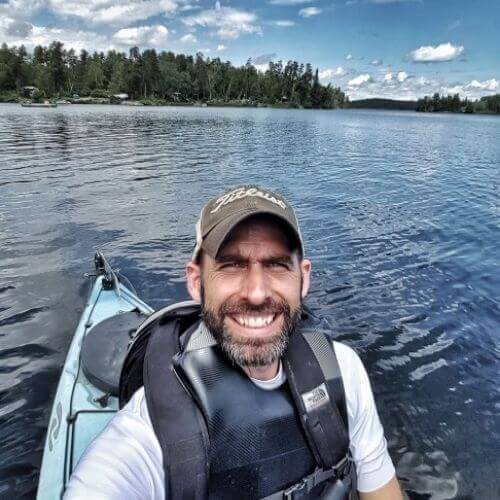
If you are a beginner, there might be hundreds of questions in your mind about kayaks and kayaking. One of the most important questions is how often kayaks tip over. Many people think kayaks flip over easily, which is why they fear kayaking. But, this is not the case.
Kayaks don’t flip over easily unless you make a mistake. A few inappropriate actions can result in your kayak flipping over. The actions include imagining yourself, taking wrong turns, or kayaking into rapids with the wrong kayak. These are the reasons behind a kayak’s tip-over. Besides that, a kayak is rarely flipped over.
To get in-depth into this question, you need to understand the fact that what makes a kayak tip over easily. So, here is a complete guide that will help you understand the whole science.

Kayaking is a fun activity that everyone can enjoy. However, it is important to remember that kayaks don’t flip over easily unless you make a mistake. If you are thinking about doing something that has the potential to result in your kayak flipping over, here are some common reasons behind this:
Imbalancing yourself in the water: You may know that kayaking is all about balancing yourself and your boat on the water. But the problem occurs when you suddenly imbalance yourself on the kayak; this can result in an unexpected flip-over.
For example, if you suddenly turn your head on the backside while kayaking, this will change the center of gravity, resulting in a tip-over.
Taking wrong turns: Kayaking is all about technique, and when you do something wrong while paddling, it may result in your kayak tipping over.
For example, if you are going on calm water but suddenly try to take a narrow turn while on a large-sized kayak, it will result in imbalance and accidental tip-over.
Kayaking into rapids with the wrong type of kayak: There are different kayaks for different water types. The problem occurs when you use the wrong type of kayak in a different situation.
For example, you own a recreational kayak that is suitable for calm water, but you take it on whitewater where there are high chances that you will hit waves and rapids. Your kayak will not be able to stand against them, resulting in an unexpected flip-over. And this is very dangerous because anything can happen when you accidentally fall inside the water.
Following the tips below, you can easily prevent your kayak from tipping over. These tips will help you safely paddle your kayak on different types of water.
There are several ways to prevent your kayak from tipping over. One of the most important ones is maintaining the balance of your boat.
Balance is maintained by adjusting your weight distribution and angling yourself so that you sit in the boat’s center. This will help keep you upright, preventing you from falling out of the boat. You can also reduce the time you’re standing in one place while on the water by using a footrest or sitting on a seat cushion while paddling.
If you are paddling or sitting in one spot for too long, try shifting your weight around so that it’s distributed evenly throughout all parts of your body as much as possible. This will help maintain balance and keep you upright when paddling.
The best way to maintain balance on your kayak is by keeping it level. So, don’t lean one way or another as you move around. Also, don’t paddle too fast; slow down when there’s no wind, so you don’t pop right out of the water.
The second trick is using the right kayak according to the water condition. For example, don’t use a long-tail kayak if you’re fishing in a lake with high waves and currents. It’ll be hard for you to paddle, and it’s not easy for you to control. Instead, use a short tail because this kind of kayak is easier to control and move around in the water.
Remember, kayaks are available in various shapes and sizes, depending on their intended purpose. A fishing kayak, for example, has a flat bottom and is ideal for use in lakes and rivers, while a touring kayak has a rounded bottom and can be used for both lakes and rivers.
If you have a flat-bottomed fishing kayak, you should use it in still waters; if you have a round-bottomed touring kayak, then use it in moving waters.
Using the right kayak on the right water is the best way to prevent accidental tip-overs.
There are two techniques that you can use to prevent trips over. Both techniques are beneficial when waterways hit your kayak’s sides.
High Brace: Imagine you are paddling on the water, and suddenly a powerful wave hits your kayak from the right size. Here you will use the high brace technique to prevent flip-over. You will have to adjust your paddle to the horizontal position and slightly push on the water with the paddle on the left side of the kayak.
This will help you balance yourself and the kayak on the water, preventing the boat from flipping over.
Low Brace: This is a very similar technique to a high brace. All you have to do is push on the water while also moving your body in the direction where the wave hit the kayak. This will prevent your kayak from flipping over on the water.
If you don’t understand the techniques, the following video tutorial is for you.
If you want to prevent your kayak from tipping over, it’s important to remember that the weight limit of your boat is not just a matter of aesthetics. It’s also a matter of safety.
Even though it might seem like the weight limit is just there so you can be nice and show off your boat to other people, the truth is that if you go over the weight limit for your kayak, you are at risk of falling into the water or flipping over your kayak.
So, if you have a boat that has a weight capacity of 300 pounds, then you must stay under that limit at all times. If you weigh more than 300 pounds, then the kayak’s efficiency will be compromised, increasing the chances of flipping over the kayak.
The greater the weight in your kayak, the more likely it will be imbalanced and tip over. If you are unsure how much weight your kayak can hold, consult with an experienced paddler or try to weigh your kayak before and after you take it out on the water.
Obstacles are one of the most common causes of kayak tip over. When paddling, keep your kayak as close to the water as possible. If there is any chance that you might run into an obstacle, it’s best not to go around it. The more space you give yourself by going around an obstacle, the less likely you will hit it and flip over.
If you are paddling and you come across a rock, log, or tree, don’t stop on top of it! Instead, find a way around it.
It’s also important to avoid stopping near other boats or obstacles that might cause your boat to run into each other. If there are other boats in the area, try to paddle around them if possible.
It’s great to be prepared, but it’s even better if you’re ready for anything. One of the most common causes of tip-over is the inability to get out of your kayak quickly if you fall into the water.
This is why it’s important to know how to swim and practice so that you can do it quickly and easily. You should also wear a life vest when on the water, which will help keep you afloat if you fall into water.
You can definitely get stuck upside down in a kayak! It’s happened to me, and I’ve even seen it happen to other people.
If you’re kayaking, and your boat capsizes, which means that you’re leaning over and the water is under you, your boat will be upside down. If you’re not wearing a lifejacket and there are no other boats around to help pull you out of the water, you’ll be stuck upside down for a long time.
You should always wear a lifejacket when you go out on the water, especially if there’s any chance of an overturning or capsizing. The lifejackets are designed to keep people from sinking if they fall overboard, so they’ll come in handy if something goes wrong.
First, try to come out of the kayak while strongly holding the above side of your kayak. Once you are out of your kayak, try to climb it on the above side with the help of your legs.
If you cannot climb the kayak, try to swim sideways and towards the shore. If you have a lifejacket on and it inflates, hold onto it for as long as possible to help keep you afloat.
In the end, I recommend you always wear a life jacket whether you paddle with the right kayak on the water because anything can happen. Besides, kayaks aren’t flipped over easily unless you make a mistake that is mentioned above. That is why I have included some tips that will surely help you prevent tipping over your kayak on the water.

Hey there kayak lovers! I’m Jay Schwartz, the author here at Kayak Guidance! You know water sports – you know me! My life is all about it. Kayaking, Paddleboarding, Fishing, Snorkeling and so much more. I love to share my passion and knowledge with all of you.

Hey there kayak lovers! I’m Jay Schwartz, the author here at Kayak Guidance! You know water sports – you know me! My life is all about it. Kayaking, Paddleboarding, Fishing, Snorkeling and so much more. I love to share my passion and knowledge with all of you.

Welcome to KayakGuidance.com! If you’re looking to have some fun outdoor water adventures, then you have come to the right place. We help our readers find the best kayaks and water related equipment to help you have the best time of your life whenever you are engaging in water activities.
This site is a participant in the Amazon services LLC associates program, an affiliate advertising program designed to provide a means for sites to earn advertising fees by advertising and linking to Amazon.com.